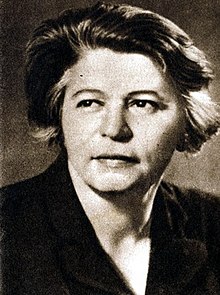Ana Pauker
| Ana Pauker | |
|---|---|
 |
|
| Minister of Foreign Affairs | |
|
In office 30 December 1947 – 9 July 1952 |
|
| President |
Constantin Ion Parhon Petru Groza |
| Prime Minister |
Petru Groza Gheorghe Gheorghiu-Dej |
| Preceded by | Gheorghe Tătărescu |
| Succeeded by | Simion Bughici |
| Personal details | |
| Born |
Hannah Rabinsohn December 13, 1893 Codăești, Vaslui, Romania |
| Died | June 3, 1960 (aged 66) Bucharest, Romania |
| Nationality | Romania |
| Political party | Romanian Communist Party |
| Other political affiliations |
Social Democratic Party of Romania Socialist Party of Romania |
| Spouse(s) | Marcel Pauker |
| Children | Tanio, Vlad, Tatiana, Masha (Marie), Alexandru (adopted) |
| Residence | Bucharest, Switzerland, Paris, Berlin, Vienna, Moscow |
| Occupation | Communist activist |
| Profession | Teacher |
| Parents | Sarah and (Tsvi-)Hersh Kaufman Rabinsohn |
Ana Pauker (born Hannah Rabinsohn; December 13, 1893 – June 3, 1960) was a Romanian communist leader and served as the country's foreign minister in the late 1940s and early 1950s. Ana Pauker became the world's first female foreign minister when entering office in December 1947. She was also the unofficial leader of the Romanian Communist Party right after World War II.
Pauker was born into a poor, religious Orthodox Jewish family in Codăești, Vaslui County (the region of Moldavia), the daughter of Sarah and (Tsvi-)Hersh Kaufman Rabinsohn. Her father was a ritual slaughterer and synagogue functionary, her mother a small-time food seller. They had four surviving children; an additional two died in infancy. As a young woman, she became a teacher in a Jewish elementary school in Bucharest. While her younger brother was a Zionist and remained religious, she opted for Socialism, joining the Social Democratic Party of Romania in 1915 and then its successor, the Socialist Party of Romania, in 1918. She was active in the pro-Bolshevik faction of the group, the one that took control after the Party's Congress of May 8–12, 1921 and joined the Comintern under the name of Socialist-Communist Party (future Communist Party of Romania). She and her husband, Marcel Pauker, became leading members. They were both arrested in 1923 and 1924 for their political activities and went into exile in Berlin, Paris, and Vienna in 1926 and 1927. In 1928, Ana Pauker moved to Moscow to enter the Comintern's International Lenin School, which trained the top functionaries of the Communist movement. There, she became closely associated with Dmitry Manuilsky, the Kremlin's foremost representative at the Comintern in the 1930s.
...
Wikipedia
